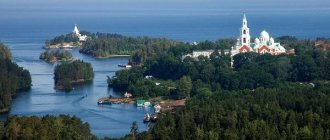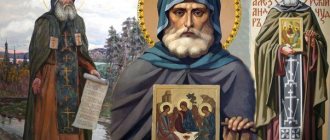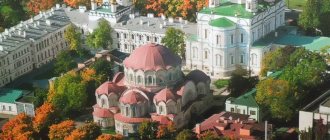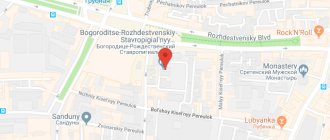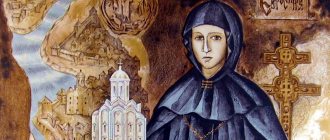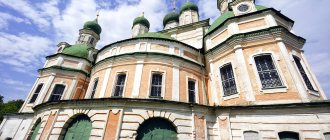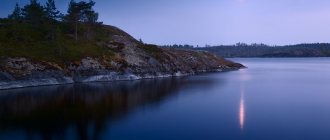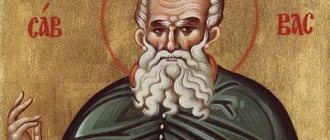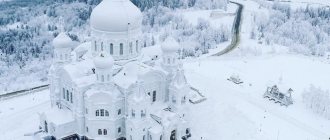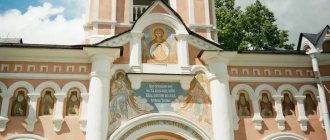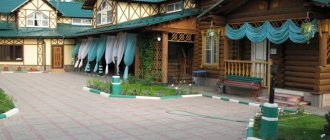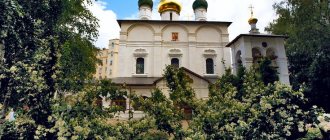The Valaam Transfiguration Monastery of the Russian Orthodox Church is located on the islands of the Valaam archipelago in Karelia, on the northern outskirts of Russia, near the border with Finland. The Valaam archipelago consists of 50 separate islands located in Lake Ladoga, 22 km from the mainland. The holy monastery occupies the largest island - Valaam, 9.6 km long and 7.8 km wide. The Valaam Monastery - stauropegial - is subordinate to the Patriarch of Moscow and All Rus', but in fact the abbot controls the monastery.
Where is the Valaam Monastery located?
The holy monastery is located in Karelia, on a huge island in the northern part of Lake Ladoga, or rather on an entire archipelago of more than 50 individual islands. The largest of them is the island of Valaam, but other areas of land also belong to the territory of the monastery.
Valaam and the coast are separated by about 22 km. The nearest settlement near Valaam is the city of Sortavala, it is located 42 km from the monastery. Despite the fact that from the map it seems that the Valaam Monastery is located not far from St. Petersburg, in fact it is more than 200 km from the northern capital to the holy monastery.
Description of the Valaam Monastery
The Valaam Monastery in Karelia belongs to the category of stauropegial, which means that the monastery is directly subordinate to the Patriarch of Moscow and All Rus', although the actual management of the monastery according to the ancient charter is carried out by the abbot.
The ancient holy monastery occupies the huge island of Valaam with an area of about 30 square meters. km, the monastery's hermitages are scattered across fifty small islands in the immediate vicinity. The monastery is located in a very picturesque corner of nature - a rocky island rises high above sea level, the territory of Valaam is covered mainly by pine forests. The island has several internal lakes and a network of canals, artificially created in the 19th century.
In the video of the Valaam Monastery you can see that the monastery complex is very large and difficult to explore in one day. The monastery includes many churches, chapels and memorial crosses. Among the most famous buildings are the Transfiguration Cathedral and the White and Red Monasteries, the Church of the Assumption of the Blessed Virgin Mary, and the ancient houses of the Valaam Monastery.
On the territory of the Spaso-Preobrazhensky Valaam Monastery there are many outbuildings - a hotel founded in the ancient building of the Stable House, a Waterworks House, a bakery and a dairy farm, its own vehicle fleet and a modern outpatient clinic. The monastery owns arable land and orchards; the Valaam Monastery farm operates on the island. Throughout the year, the monks work on Valaam in the same way as in the old days, since the life of the island consists not only of prayers, but also of constant work.
Weather on the island
I must say, it is not constant. The monastery stands on a hill, which means it is open to all winds.
Storms on Ladoga are not uncommon. But hot summers don't happen often. Sometimes there are a few really hot weeks of the year, but even then the temperature rarely exceeds 20°C.
Hermitages of the Valaam archipelago
The monasteries of the Valaam Monastery deserve special consideration. The small temples and residential buildings on the small islands of the archipelago have great religious significance and a rich history.
White Monastery
The White Skete, or Skete of All Saints, is located on the Skete island of the same name. The monastery was founded at the end of the 17th century; initially it had several fraternal buildings and a stone church. The White Skete has particularly strict rules - female pilgrims are practically prohibited from entering here; you can only visit the territory of the skete on All Saints' Day during a religious procession.
Skete of John the Baptist
The monastery on Predtechensky Island was built in 1855 and at that time was a simple wooden chapel. In 1858, a wooden church with a bell, cast especially for the Valaam Monastery under Boris Godunov, was erected in its place. At the beginning of the 20th century, ancient crosses from the 17th and 18th centuries were kept in the monastery, as well as the ashes of Schemamonk Jonah, revered on Valaam.
Currently, monks still live in the monastery. However, you cannot go on an excursion to the monastery - the Forerunner Monastery is completely closed to visitors.
Red Monastery
The Red Monastery, which is also called the Resurrection or New Jerusalem, is located in the southern region of the island of Valaam. According to legend, it was on this spot that the cross was originally installed by the Apostle Andrew the First-Called himself. In 1846, a wooden chapel was erected on the site of the cross, and at the beginning of the twentieth century it was replaced by a two-story church. The monastery received its unofficial name, Red, because its buildings are made of red brick.
Monastery of St. Nicholas the Wonderworker
The small monastery on Cross Island was built in the mid-19th century and initially consisted of the Church of St. Nicholas the Wonderworker and the Church of St. John of Damascus. A few years after construction, a stone building with cells for the brothers was added; also in the 19th century, a lighthouse was located in the chapel of St. Nicholas the Wonderworker; lanterns were lit in the windows on especially dark nights.
Konevsky monastery
Konevsky monastery is located on Konevets Island on the shore of Lake Igumenskoye. The consecration of the monastery took place in 1870, but in the middle of the 20th century, under Soviet rule, the monastery was dismantled. In 2004 it was restored and re-consecrated. The monastery is known for the fact that in former times, not far from it, there was a cell of Hegumen Damascene, the abbot of the monastery from 1839 to 1881, who made a great contribution to the development and prosperity of Valaam.
Gethsemane Monastery
Gethsemane, or Yellow, monastery is located near the Mount of Olives and includes the Ascension Chapel, the Chapel of the Prayer of the Chalice and the Church of the Assumption of the Blessed Virgin Mary. The monastery was founded at the beginning of the twentieth century, but during the years of Soviet power it suffered quite a lot; restoration work is still underway on the territory of the monastery. The skete was re-consecrated in 1998.
Who founded the Valaam Monastery
The identity of the founder of the Valaam Monastery and the exact year of its foundation still remain in question. The monastery is so ancient that there is simply no reliable evidence of the beginning of its existence.
- Based on the life of St. Abraham of Rostov, it is suggested that the monastery was founded at the beginning of the 10th century by the monks Herman and Sergius, who came to Valaam from the Mediterranean and founded a monastic brotherhood on the island. At the same time, there are no written sources that would tell about the life of the monks themselves, but a number of chronicles mention the transfer of their relics in 1163 from Valaam to Novgorod.
- According to the texts of the life of Savvaty Solovetsky, the year of foundation of the monastery on Valaam is considered to be 1407.
- According to legend, the founder of the Valaam monastery is the Apostle Andrew the First-Called himself, who brought the good news of Christ to the northernmost lands and erected a stone cross on the rocks of Valaam.
Attention! In fact, it is possible to trace the history and development of the Valaam monastery only from the 16th century; it was during this period that references to the monastery begin to appear frequently in written sources.
plumbing house
It was built at the end of the nineteenth century.
In order for water supply to appear on the island, the builders had to dig a 142 m long tunnel into the granite.
An iron pipe was installed inside, inside which drinking water, under the influence of a powerful pump, rose into the tower to a height of 40 m. The uninterrupted operation of the water supply was ensured by the action of a steam engine. Before the advent of running water, monks carried heavy buckets up the mountain; starting the mechanism made their life easier.
What is Valaam Monastery famous for?
It is not for nothing that the Spaso-Preobrazhensky Valaam stauropegic monastery is one of the most famous monastic monasteries in Russia and the whole world. Every year tens of thousands of pilgrims come here, attracted by the ancient history of the monastery, the stunningly beautiful nature of Valaam and the special atmosphere that reigns on the island remote from civilization.
- Valaam is one of the most ancient monasteries in the Christian world. The legend directly connects its foundation with Christ’s disciple Andrew the First-Called, and even according to reliable written sources, the age of the monastery is at least 500 years.
- Valaam is located in an amazingly beautiful and clean natural area and is located at a considerable distance from the “world”, thanks to which during a trip to Valaam you can truly relax your soul from ordinary worries.
- On the vast territory of the Valaam Monastery there are many historical buildings and ancient temples, some of them have been preserved from ancient times, others have been restored in modern times. Valaam is of interest not only to pilgrims, but also to historians and cultural experts around the world.
- Many important Orthodox shrines are kept within the walls of the monastery - every year pilgrims come here to venerate the images and relics, ask for healing or enlightenment.
One of the most important features of the Valaam Monastery on Lake Ladoga is its particularly strict internal charter. It is not for nothing that the monastery is called “northern Athos” - the monks of Valaam avoid any worldly temptations, preach strict asceticism, work hard and truly devote their lives to serving God.
Tips for tourists
On a trip to the island of Valaam you should take with you:
- Passport and medical insurance.
- Mobile phone and power bank.
- Personal hygiene products.
- Individual medications.
- 2-3 skirts and scarves (for women).
- A set of spare clothes (for everyone).
- Wear comfortable shoes appropriate for the weather, heels are not recommended.
- Money for the return trip, even if it has already been paid, in case you fall behind the group.
Particular attention should be paid to collecting a personal or family first aid kit. There are no clinics, medical posts or doctors on the island. The amount of medicine that monks have is extremely limited. Medicines for the monks are purchased from donations, and supplies may be interrupted. If you are concerned about your health, it is better to refuse the trip or reschedule it to other dates.
In theory, you can get to the monastery in winter, by car on the ice of Lake Ladoga. But the monks do not approve of this (“they do not bless”, as Orthodox people say). Winter for monks is a time of rest from tourists, a time for prayer and spiritual development. In addition, driving a car on ice is potentially dangerous.
The monastery does not hold weddings, baptisms of children, reprimands of the possessed, or other sacraments. All these rituals are performed by parish priests, not monks. While visiting the monastery, you can submit notes for the health and peace of people and purchase religious souvenirs.
The Valaam Monastery is located in a beautiful picturesque place, where everyone can feel harmony in the soul and take a break from the daily bustle. Even people far from religion should visit this place. A trip to Valaam will help you not only study the history and culture of our country, but also gain a deeper understanding of yourself.
Author: Abramova Anna
Article design: Vladimir the Great
History of the Valaam Monastery
The exact date of foundation of the Valaam Monastery remains unknown - some sources place the foundation of the monastery in the 10th century, according to others, the monastery was founded in the 14th century. It is officially accepted that the history of the monastery began in 1407, and its founders were the pilgrims Herman and Sergius.
The monastery experienced its greatest prosperity in the 15th-16th centuries, when about 600 monks lived on its territory. At the beginning of the 17th century, Valaam fell into decline; during this period the island came under the control of Sweden, as a result of which the monastery was severely devastated. After the Northern War, the island returned to the borders of Russia, and by order of Peter I, the restoration of the monastery began in 1715.
In 1730, the wooden Assumption Cathedral was erected, but it did not last long; a fire in 1754 destroyed almost all the buildings. The next restoration of the monastery was facilitated by Empress Elizabeth. In 1774, the Cathedral of the Transfiguration of the Lord, the Assumption and St. Nicholas churches, as well as cell buildings were erected. Another 10 years later, under Abbot Nazariya, stone construction began on the territory of the monastery.
With the beginning of the 19th century, Valaam flourished again; active development was carried out on the territory, some of which has survived to this day. In 1839, the famous abbot of Damascus became the abbot of the monastery, who made a huge contribution to the architectural development of the monastery. Damascene not only initiated the construction of new cathedrals and churches, but contributed to the revival of classical monastic traditions in the monastery. The eldership was returned again, the rules of the monastery became much stricter, and its fame increased.
At the end of the 19th century, the number of inhabitants of the monastery was about 1000, and there was also a tendency to assign names from the New Testament to the surrounding area of the temple. The clergy hoped that soon the Valaam Monastery of the Transfiguration of the Savior could become the new Jerusalem.
In the twentieth century, difficult times came to Valaam. After the revolution, the monastery was not closed, since it was located not in Russia, but in Finland. However, changes came anyway, since Orthodox believers in Lutheran Finland were in the minority, and in 1923 the monastery was de-Russified. Divine services began to be held there in Finnish, and defensive structures were placed on the territory of the monastery in case of war with the Soviet Union. The monastery was forced to switch to the Gregorian calendar, and many monks left the monastery. During the Finnish-Soviet war, the exodus of monks from the Valaam Monastery intensified - the monks went to Finland and subsequently founded the New Valaam Monastery there.
In the 1930s, only about 400 monks remained in the monastery, suffering poverty and hunger. In 1940, after the return to the USSR, the monastery was finally closed, and a naval school was located on the territory of the monastery. In 1950, the territory of the monastery was given over to a home for the disabled, and in 1979 a museum-reserve was opened on Valaam.
The revival of the monastery began only in 1989, the Orthodox Church again took possession of most of the monastery buildings. In December 1989, 6 monks settled on the island, trying to revive the traditions and customs of Valaam, and in 1994 the monastery was re-consecrated.
Shrines of the Valaam Monastery
On the territory of the Valaam monastery there are many important shrines of the Orthodox world. Among them are:
- the relics of the venerable monks Sergius and Herman, they are kept in the Transfiguration Cathedral of the Valaam Monastery and are an object of worship for pilgrims from all over the world;
- The Valaam Icon of the Mother of God, a miraculous image painted in 1878 by the monk Alypius;
- the icon of St. Anna, this image is an exact copy of the original kept on Mount Athos, and according to legend, it saves women from infertility.
Also on Valaam there is a piece of the Holy Sepulcher from the Holy Land - the relic is kept in the Resurrection Skete of the monastery.
Recommended by topic
Intercession Convent Ioannovsky Monastery Alexander Nevsky Lavra
the Monk Alexander of Svirsky lived here in the 15th century . Women are not blessed to enter the territory of this monastery.
Another famous monastery is Smolensky . It is named after the Smolensk Icon of the Mother of God . The temple that is located here was built during the First World War and is a monument to all fallen soldiers. Even the dome of the temple is made in the form of an old Russian helmet.
Monks of the Valaam Monastery
The Valaam Monastery on the marvelous island of Valaam is famous for its strict rules, which largely repeat the traditions of the famous Athos. Currently, more than 200 monks live in the monastery, busy daily with prayers and hard work. The daily routine for the brethren of Valaam is as follows:
- at 17 o'clock in the evening, Little Compline begins in the monastery, followed by the monastic rule, three canons with an akathist to the Mother of God and the rite of forgiveness;
- at 21 o'clock after dinner there comes a time of silence, during which the monks read prayers in private and bow;
- at 22 o'clock one goes to bed, and already at 5 o'clock in the morning the Midnight Office and Matins take place;
- after this, an early liturgy is served, after which the monks go to morning tea and subsequent obediences;
- At 1 p.m., lunch follows, after which the works of the holy fathers are read and a prayer service is served at the relics of St. Herman and Sergius.
A feature of the life of monks is that each of the monks is under the authority of a spiritual father or abbot. The time and duration of cell prayers are determined individually for each monk.
Strict rules apply on the territory of the Valaam Monastery regarding the sleep of monks. At night, 4 to 5 hours are allotted for rest; monks can sleep another 1-2 hours during the day after lunch. According to the abbot of the Valaam Monastery, Hegumen Pankratiy, the rule on the duration of sleep is taken from the patristic books; they recommend sleeping no more than 6-7 hours.
Important! The choir of the Valaam Monastery is very famous; its members include graduates of the Choir School named after. Glinka and the St. Petersburg Conservatory. Rimsky-Korsakov, certified vocalists and conductors, singers of musical theaters and vocal groups of St. Petersburg.
How to get to the Valaam Monastery
The holy monastery, located on the northern outskirts of the country, can be reached both from the capital and from St. Petersburg. It is most convenient to use a car, but there are also public transport routes, although in this case you will have to travel with transfers.
How to get to the Valaam Monastery from Moscow
The easiest way to get to the holy monastery from the capital is to travel by car. From Moscow you need to drive along the Leningradskoye Highway, then along the M10 highway to reach St. Petersburg, go around it and get onto the A121 highway, along which you proceed to Priozersk. You can get to the island from Priozersk by water; a passenger ship and a meteor boat go to the pier of the Valaam Monastery every day.
Another way to get to your destination from the capital is to take a plane or train to first get to St. Petersburg, and then take a regular bus at the Northern Bus Station to Priozersk. Also from the Ladozhsky station you can get to the city of Sortavala and board a motor ship or boat.
How to get to the Valaam Monastery from St. Petersburg
You can also get to Valaam from the northern capital by car; to do this, you need to go to Priozersk along the A121 highway, and then transfer to a motor ship or boat at the city pier.
There are other ways to get to the Valaam Monastery:
- by train to Priozersk - you need to board the train at the Finnish station, the journey takes about 3 hours, and you can get to the pier from the railway station by taxi or bus;
- by regular bus - transport from the Northern Bus Station of St. Petersburg goes to Priozersk daily, the journey also takes about 3 hours;
- by train to Sortavala - you need to board the train at the Ladozhsky railway station; the Sortavala railway station is only 1.5 km from the pier.
Important! In the summer, excursions to the Valaam Monastery from St. Petersburg depart from Petrovskaya Embankment; meteor boats and motor ships go directly to the island. This route allows you to avoid transfers, but the travel time takes about 10 hours.
Excursions to the Valaam Monastery
Since Valaam is not only a place of pilgrimage, but also an important cultural site of world significance, you can get to the island as part of a tour of the Valaam Monastery from Moscow or another Russian city.
- There are tours of the estate of the Valaam Monastery and the hermitages of the monastery, group and private excursions with an individual guide.
- On average, tours can take from 1 to 4 days, given the size of the monastery, it is best to go to Valaam on a long tour, this will allow you to see more sights.
- Some tours to Valaam involve active exploration of the island, others are offered in the format of a free holiday, in this case the organizers book accommodation for tourists and deliver to their destination, and after a few days they take travelers back.
- Excursions around the island and the monastery are organized by the Valaam Monastery itself; tickets can be purchased through the monastery’s Pilgrimage Service.
Tourists and pilgrims can stay on the island at the monastery hotels - “Winter”, “Igumenskaya”, “Attic” and “Slavyanskaya”. It is better to book places in advance, since the influx of tourists to Valaam is always very large.
Advice! It is better to plan a trip to the Valaam Monastery in summer and winter. Access to the island is limited; moreover, most of the buildings are not heated and are therefore closed to the public.
Catering
All those who have purchased tickets for the excursion tour are provided with three meals a day at the hotel, which is included in the price of the trip. The menu is agreed separately with the tour operator. Meals for pilgrims, workers and volunteers take place in the monastery canteens according to the Orthodox menu, which takes into account fasting and fasting days.
Breakfast, lunch and dinner occur strictly according to schedule. There is no need to take dishes on your trip; everything is provided on site. It is not prohibited to take your own food on a trip, but it is considered indecent to snack on the go during excursions and holy places. It is polite to put away dirty dishes after eating.
There are no hired personnel on the island who work for money. All work is done by workers, novices and volunteers.
It is not necessary for tourists who do not profess Orthodoxy to pray before eating. But if someone is reading a prayer at the table, you should stand up and wait until it ends. It is impolite to sit down and start eating while someone else is praying nearby. During the monastic meal, all the usual rules of behavior at the table apply: you cannot talk with your mouth full, loudly knock with cutlery, etc.
Rules for visiting the Valaam Monastery
Valaam is a popular tourist destination, but we should not forget that the island belongs to a functioning monastery. For all guests and pilgrims without exception, the Valaam Monastery establishes quite strict rules.
- Guests of Valaam must wear closed clothing; moving around the monastery in sports, beach or open clothes, shorts and miniskirts is unacceptable.
- When entering existing temples, men must remove their hats, and women must cover their heads and wear long skirts.
- Smoking or drinking alcohol is prohibited on the territory of the monastery; shouting, singing, loud laughter and the use of sound equipment are prohibited.
- Video and photography are prohibited - this applies not only to professional, but also to amateur photography; in order to take a photo of the Valaam Monastery, you need the permission of the abbot.
- Pets and birds are not allowed into the monastery territory.
- It is forbidden to hold any public events or religious activities on the territory of the monastery, other than those permitted by the monastery, and visiting churches during services is possible only in accordance with the internal regulations of the monastery.
Of course, tourists on Valaam are not allowed to make fires or pick mushrooms and berries, hunt and fish, engage in trade, or take items of historical and cultural value from the island.
Interesting facts about Valaam Monastery
The monastic monastery on the island of Valaam has some unique features. For example, the following facts are known:
- the monastery has its own emblem, it was created in 2015;
- Every year the monastery is visited by about 100,000 people, mainly tourists, and the monastery hotels can accommodate up to 200 people at a time;
- Due to the large influx of tourists and pilgrims, Abbot Pankratiy made a proposal to establish a special procedure for visiting Valaam for guests of the island, to determine a clear maximum number of pilgrims per season in order to reduce the burden on the nature of the island and on the monastery hotels.
It is interesting that it is quite difficult to take monastic vows in the Valaam monastery - out of 20 workers, on average, only 1 remains to begin monastic life here. This is due to the strictness of the charter; not everyone finds the strength to comply with it.
Abbots, governors
- Feofan (992),
- Martyrius (1192),
- Porfiry (1332),
- Strength (1417),
- Joachim II (1474),
- David,
- Savvaty,
- Ignatius,
- Joachim III (1507),
- Isaiah, called the builder (1540),
- Nicodemus (1578),
- Gennady (1585),
- Theodoret I,
- Theodoret II,
- Isaiah II,
- Varlaam,
- Photius,
- Macarius,
- Ephraim,
- Matthew,
- Lavrenty,
- David (1598)
- Macarius (1606)
- …
- St. Nazarius (1781 - 1801)
- …
- Apollinarius (Ivanov) (August 17, 1907 - October 25, 1908)
- …
- Mauritius (mentioned 1914)
- …
- Khariton (Dunaev) (1927 - 1932)
- Khariton (Dunaev) (1933 - 1940)
- Andronik (Trubachev) (1990 - 1993)
- Pankratiy (Zherdev) (from January 18, 1993)
